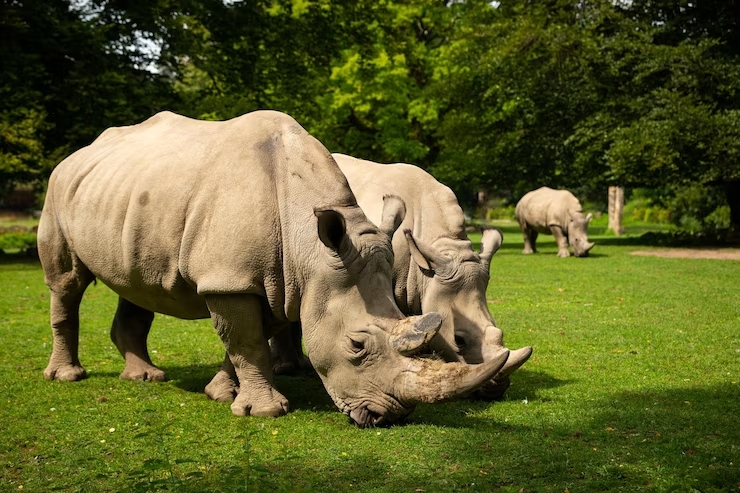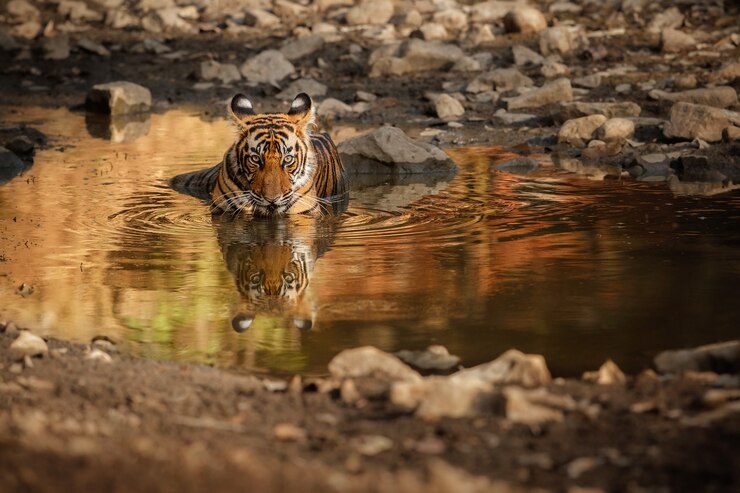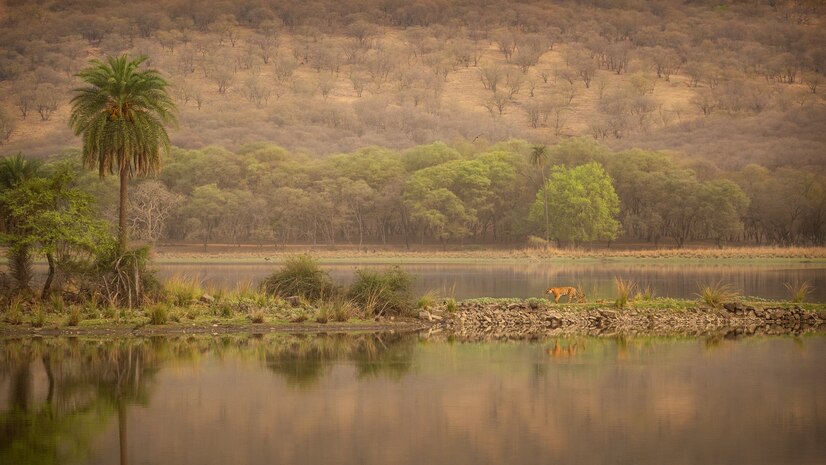Embark on a journey through the heart of India’s untamed landscapes as we delve into the wild wonders of the country’s breathtaking wildlife sanctuaries. From the snow-capped peaks of the Himalayas to the lush greenery of the Western Ghats, India boasts an incredible diversity of flora and fauna protected within these sanctuaries. Join us in this exploration of nature’s marvels and discover the unparalleled beauty and significance of India’s wildlife sanctuaries.

1. Kaziranga National Park – A Haven for Rhinos:
Nestled in the northeastern state of Assam, Kaziranga National Park stands as a symbol of conservation success. Home to the Indian one-horned rhinoceros, Kaziranga’s sprawling grasslands and water bodies also host a vibrant array of wildlife, including elephants, tigers, and various bird species. Explore the wonders of this UNESCO World Heritage Site, where every moment is an encounter with the untamed.
Established in 1905, Kaziranga has emerged as a symbol of successful wildlife conservation, particularly for the Indian rhinoceros (Rhinoceros unicornis). It boasts the highest population density of this species in the world, with over two-thirds of the global population residing within its boundaries. This iconic park is not only a sanctuary for rhinos but also serves as a sanctuary for numerous other species, including tigers, elephants, wild water buffalo, and a myriad of bird species.
The park’s landscape is a mosaic of grasslands, wetlands, and dense forests, crisscrossed by the mighty Brahmaputra River and its tributaries. This diverse ecosystem provides a perfect habitat for a plethora of wildlife. Kaziranga is renowned for its rich avifauna, with over 500 species of birds, including migratory ones like the bar-headed goose and the greater adjutant stork, making it a birdwatcher’s paradise.
One of the most enchanting aspects of Kaziranga is its exhilarating safaris, offering visitors the opportunity to witness wildlife up close in their natural habitat. Jeep safaris and elephant rides are popular ways to explore the park, allowing visitors to traverse through its grasslands and dense forests, catching glimpses of rhinos, tigers, herds of elephants, and a myriad of other fascinating creatures.
However, Kaziranga’s success story is not without its challenges. The park faces persistent threats from poaching, habitat loss due to human encroachment, and natural calamities like floods. Despite these challenges, the dedicated efforts of park authorities, conservationists, and local communities have ensured the continued survival and thriving of its precious inhabitants.
In recent years, Kaziranga has also emerged as a pioneer in innovative conservation practices. Community-based initiatives, eco-tourism ventures, and collaborations with international organizations have played a pivotal role in safeguarding the park’s biodiversity while promoting sustainable development in the region.
As a testament to its significance, Kaziranga National Park continues to draw visitors from across the globe, enchanting them with its unparalleled natural beauty and awe-inspiring wildlife encounters. Beyond its role as a sanctuary for rhinos, Kaziranga stands as a shining example of what dedicated conservation efforts can achieve, inspiring hope for the preservation of our planet’s natural heritage for generations to come.

2. Ranthambhore National Park – Where Tigers Roam Free:
In the heart of Rajasthan lies Ranthambhore National Park, a realm where the majestic Bengal tiger reigns supreme. The park’s historic backdrop, with the ancient Ranthambhore Fort looming over the landscape, adds an extra layer of charm to the wildlife experience. Venture into the wild on a safari, and you might just witness the regal tigers in their natural habitat.
Ranthambore’s history is as rich and vibrant as its landscapes. Once a hunting ground for Maharajas of Jaipur, it was declared a wildlife sanctuary in 1955 and later gained the status of a national park in 1980. The park’s topography is a blend of dry deciduous forests, meadows, lakes, and rugged hills, creating a perfect habitat for a myriad of species, including the critically endangered Bengal tiger.
The park’s crown jewel is undoubtedly the Bengal tiger, and Ranthambore boasts a healthy population of these magnificent predators. Visitors to the park are often treated to the awe-inspiring sight of a tiger gracefully navigating its territory or lounging beneath the shade of ancient trees. The park’s well-maintained network of trails and watchtowers offers ample opportunities for wildlife enthusiasts and photographers to observe these majestic creatures in their natural habitat.
Beyond the iconic tigers, Ranthambore is home to a diverse array of wildlife. Leopards, sloth bears, wild boars, and spotted deer roam freely amidst the dense foliage, while crocodiles bask in the sun along the park’s tranquil lakes. The avian population is equally impressive, with over 300 species of birds, including the endangered Indian eagle-owl and the vibrant painted stork, making Ranthambore their home.
Apart from its remarkable wildlife, Ranthambore is steeped in history and culture. The park’s boundaries encompass the majestic Ranthambore Fort, a UNESCO World Heritage Site dating back to the 10th century. This ancient fortress stands as a silent sentinel amidst the wilderness, offering visitors a glimpse into Rajasthan’s royal past and commanding panoramic views of the surrounding landscapes.
Conservation lies at the heart of Ranthambore’s ethos, with dedicated efforts aimed at preserving its delicate ecosystem and ensuring the continued survival of its iconic inhabitants. Sustainable tourism practices, community involvement, and scientific research form the cornerstone of conservation initiatives within the park, ensuring that future generations can continue to marvel at its natural wonders.
A visit to Ranthambore National Park is a journey into the wild, where every rustle in the bushes and every call of the wild holds the promise of an unforgettable adventure. Whether you’re a wildlife enthusiast, a history buff, or simply seeking solace in nature’s embrace, Ranthambore beckons with its untamed beauty and timeless allure – a sanctuary where tigers roam free and the spirit of the wild thrives.

3. Periyar Wildlife Sanctuary – A Tropical Paradise:
Hidden in the Western Ghats of Kerala, the Periyar Wildlife Sanctuary is a tropical haven for wildlife enthusiasts. The shimmering Periyar Lake adds a scenic touch to the lush surroundings, creating a picturesque setting for observing elephants, sambar deer, and a myriad of bird species. Take a boat safari to explore the sanctuary from a unique perspective.
The sanctuary takes its name from the Periyar River, which meanders through its verdant forests, adding to the picturesque charm of the surroundings. Established in 1950, it was declared a tiger reserve in 1978, aiming to protect the majestic Bengal tiger and its natural habitat. However, the sanctuary is not just about tigers; it is home to a diverse array of flora and fauna that thrive in its varied ecosystems.
One of the highlights of Periyar Wildlife Sanctuary is its dense evergreen and moist deciduous forests, which provide shelter to a remarkable variety of wildlife. Visitors can embark on guided safaris or boat cruises along the Periyar Lake, offering opportunities to spot elephants, sambar deer, wild boar, langurs, and an impressive array of bird species, including the vibrant Malabar pied hornbill and the elusive Nilgiri wood pigeon.
For those seeking a more immersive experience, trekking trails wind through the sanctuary, leading adventurers deep into the heart of the forest. The trails offer a chance to witness the serene beauty of the surroundings up close, with encounters with wildlife adding an element of excitement to the journey.
Beyond its ecological significance, Periyar Wildlife Sanctuary also holds cultural importance. The indigenous tribal communities, such as the Mannans, Uralis, and Malampandarams, have inhabited these forests for centuries, coexisting harmoniously with nature. Visitors can learn about their traditional way of life and cultural practices through guided tours and interactions, gaining insight into the symbiotic relationship between humans and the environment.
Moreover, the sanctuary is a hub for ecotourism initiatives aimed at promoting sustainable practices and conservation efforts. Visitors can participate in activities such as nature walks, bamboo rafting, and spice plantation tours, gaining a deeper understanding of the region’s biodiversity and the importance of preserving it for future generations.
In addition to its natural beauty and wildlife, Periyar Wildlife Sanctuary offers visitors a range of amenities, including comfortable accommodation options, interpretive centers, and eco-friendly resorts that blend seamlessly with the surrounding landscape.

4. Jim Corbett National Park – India’s Oldest Tiger Reserve:
Established in 1936, Jim Corbett National Park in Uttarakhand holds the distinction of being India’s oldest tiger reserve. The park’s diverse landscapes, ranging from grasslands to dense forests, provide a habitat for tigers, leopards, and a rich variety of birdlife. Immerse yourself in the thrill of the jungle on an adventurous safari.
Jim Corbett National Park is not only famed for its tiger population but also for its rich diversity of flora and fauna. It encompasses a variety of habitats, including dense forests, grasslands, rivers, and marshy depressions, providing a suitable environment for a myriad of species. Apart from tigers, the park is home to leopards, elephants, sloth bears, deer species like sambar and chital, along with over 600 species of birds, making it a paradise for birdwatchers.
One of the best ways to explore the wilderness of Jim Corbett National Park is through safari tours. The park offers various safari options, including jeep safaris, elephant safaris, and canter safaris, allowing visitors to venture deep into the heart of the forest under the guidance of experienced naturalists. These safaris offer a chance to witness wildlife in their natural habitat, from elusive tigers prowling through the undergrowth to vibrant bird species flitting among the trees.
Jim Corbett National Park stands as a testament to India’s commitment to wildlife conservation and sustainable tourism. Its lush forests, diverse wildlife, and scenic landscapes offer a glimpse into the beauty and majesty of the natural world. As we strive to protect and preserve our planet’s precious biodiversity, places like Jim Corbett National Park serve as invaluable sanctuaries for both wildlife and future generations to cherish and enjoy.

5. Bandipur National Park – Where Wilderness Meets Serenity:
Karnataka’s Bandipur National Park is a harmonious blend of wilderness and tranquility. As you traverse the park’s winding roads, encounter herds of wild elephants, spotted deer, and even the elusive Indian leopard. The park’s commitment to conservation and eco-tourism ensures an immersive and responsible wildlife experience.
A Sanctuary for Wildlife: Bandipur National Park, along with the neighboring reserves of Mudumalai, Wayanad, and Nagarhole, forms the Nilgiri Biosphere Reserve, one of India’s most significant protected areas for wildlife. The park’s dense forests and diverse ecosystems provide a safe haven for numerous species, including the majestic Bengal tiger, Indian elephant, sloth bear, Indian bison (gaur), and elusive leopards. Its avian population is equally rich, with over 200 species of birds gracing the skies, including the vibrant Malabar trogon and the iconic Indian roller.
A Tapestry of Flora: Encompassing an area of approximately 874 square kilometers, Bandipur is adorned with a rich tapestry of flora, ranging from moist deciduous forests to tropical mixed forests. The landscape transitions gracefully from open grassy meadows to dense thickets, creating a kaleidoscope of habitats for its inhabitants. Towering teak, sandalwood, rosewood, and giant bamboos dominate the canopy, while the forest floor is carpeted with a myriad of shrubs, climbers, and wildflowers, adding to the park’s ethereal charm.
A Paradise for Eco-Tourism: Bandipur National Park beckons nature enthusiasts and wildlife aficionados from around the globe to immerse themselves in its pristine beauty and unparalleled biodiversity. Guided safaris through the park offer visitors a chance to witness the splendor of its wildlife in their natural habitat. Whether it’s a thrilling jeep safari at dawn, a tranquil elephant safari meandering through the wilderness, or a leisurely nature walk along designated trails, every moment spent in Bandipur is an enchanting encounter with nature’s wonders.
Preserving a Legacy: Established in 1974 as a tiger reserve under Project Tiger, Bandipur has been at the forefront of wildlife conservation efforts in India. Its success story is a testament to the dedication of park authorities, conservationists, and local communities in safeguarding its precious biodiversity. Through proactive measures such as habitat restoration, anti-poaching initiatives, and community-based conservation programs, Bandipur continues to thrive as a sanctuary for endangered species and a beacon of hope for future generations.
Finding Serenity Amidst Nature: Beyond its role as a sanctuary for wildlife, Bandipur National Park offers visitors a sanctuary for the soul. The serene beauty of its landscapes, the symphony of sounds echoing through its forests, and the sense of harmony that pervades the air make it a haven for those seeking solace amidst nature’s embrace. Whether it’s the breathtaking vistas from the watchtowers, the mesmerizing sunsets over the Nilgiris, or the tranquil moments spent by the Kabini River, Bandipur casts a spell that lingers long after the journey ends.

Conclusion:
India’s wildlife sanctuaries are not just protected areas; they are living, breathing ecosystems that showcase the country’s commitment to preserving its natural heritage. From the northern reaches of the Himalayas to the southern tip of the Western Ghats, each sanctuary tells a unique tale of biodiversity and conservation. So, gear up for an adventure, and let the wild wonders of India’s wildlife sanctuaries captivate your senses, leaving you with memories of encounters with the untamed beauty of the subcontinent.